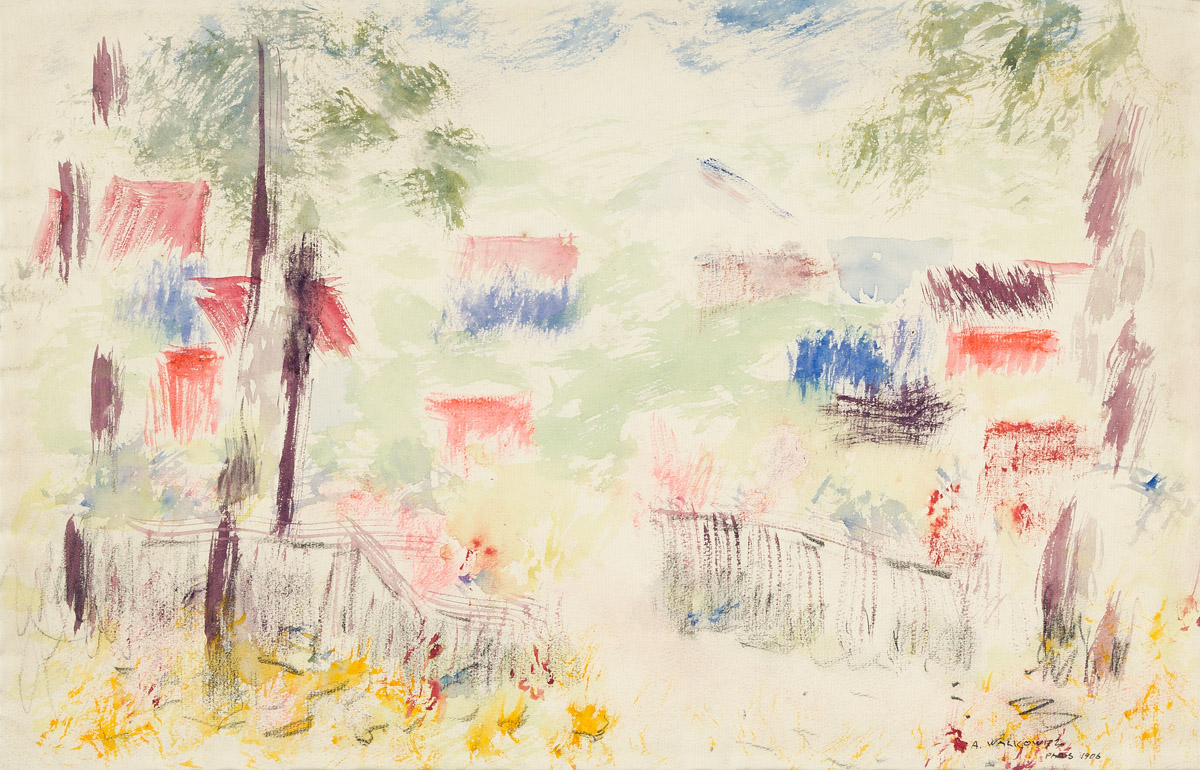Sale 2579 - Lot 12
Price Realized: $ 1,100
Price Realized: $ 1,375
?Final Price Realized includes Buyer’s Premium added to Hammer Price
Estimate: $ 2,000 - $ 3,000
ABRAHAM WALKOWITZ (1878-1965)
Two watercolors.
Landscape, France (Abstraction), watercolor on cream laid paper. 303x475 mm; 12x18 3/4 inches. Signed, titled, dated and inscribed "Paris" in ink, lower right recto. 1906 * Provincetown Rooftops, Abstraction, watercolor on cream wove paper. 295x390 mm; 11 1/2x15 1/4 inches. Circa 1912.
Provenance: Artist's estate, New York.
Exhibited: (Provincetown Rooftops, Abstraction )"Provincetown Painters 1890s-1970s," Everson Museum of Art, Syracuse, New York, April 1-June 26, 1977, with the label on the frame back.
Walkowitz was born in Tyumen, Sibera to Jewish parents and immigrated to the Lower East Side of New York with his mother in 1889. He was trained in the academic style at the National Academy of Design, New York, and at the Académie Julian in Paris, though his style was most influenced by his experiences outside of the studio. During his time in Paris from 1906-07, Walkowitz saw Isadora Duncan (1877-1927, see lot 16 and lot 17 ) dance at Auguste Rodin's (1840-1917) Paris studio and made his first drawings of her. He later recalled, "She was a Muse. She had no laws. She didn't dance according to rules. She created. Her body was music. It was a body electric, like Walt Whitman." Like Duncan's dancing, Walkowitz's drawings and watercolors were created by quick and spontaneous lines and washes of color. In Paris, Walkowitz was also impressed by the landmark 1907 Paul Cézanne (1839-1906) retrospective exhibit at the Salon d'Automne and by his introduction to the work of Henri Matisse (1869-1954) and Henri Rousseau (1844-1910). By the time Walkowitz returned to New York, his style was heavily influenced by European Modernism, with emphasis on gestures, simplified forms and flat planes of bold color. His first solo exhibition was held at Haas Gallery, the back of a modest frame shop, in New York in 1908.
In 1912, Walkowitz met Albert Stieglitz (1864-1946, see lot 1 ) through Marsden Hartley (1877-1943) and became involved with the 291 Gallery, New York, which served as a hub of American modernism. Stieglitz was so impressed by the young artist, that he sent him to study art in Greece, Italy and North Africa in 1914. His style became more abstract; its reduced linear forms lent themselves to the city's rush skyward, prematurely anticipating the New York School and the Abstract Expressionists.
In 1913, Walkowitz was represented at the Armory Show and in the 1916 Forum exhibition. Walkowitz was concerned with politics and artists' rights and was active in various artist's groups, founding the People's Art Guild and the Society of Independent Artists (he became director of the latter from 1918 to 1938). In 1920, he exhibited at the Société Anonyme alongside Man Ray (1890-1976, see lots 115-128 ), Hartley and Joseph Stella (1877-1946, see lots 44-50 ). Despite local and international recognition, Walkowitz was not nearly as well-known as his contemporaries. Virginia Zabriskie was among the many figures in the field, including Stieglitz, Henry McBride, Carl Van Vechten and Lloyd Goodrich, who thought that Walkowitz deserved more notice than he was given.
Walkowitz painted into the 1940s, when his eyesight began to fail. Zabriskie represented him during the last six years of the artist's life. She admired him for his work that was so archetypal of New York and for his passion and conviction. Zabriskie Gallery held thirteen exhibitions of Walkowitz's work and placed him in the collections of major institutions. In promoting his legacy, Zabriskie grew close to the aging artist, accompanying him to the Academy of Arts and Letters award ceremony in May 1962, where Walkowitz was given the Marjorie Peabody Waite Award for a distinguished elderly artist, to a standing ovation. After his death, Zabriskie purchased the Abraham Walkowitz Estate, including numerous watercolors and paintings left undiscovered in his studio. Zabriskie organized Walkowitz's memorial service and remembered him as a devoted, often feisty artist whose work was not fully understood in his lifetime.
Exhibition Hours
Exhibition Hours
Aliquam vulputate ornare congue. Vestibulum maximus, libero in placerat faucibus, risus nisl molestie massa, ut maximus metus lectus vel lorem.










